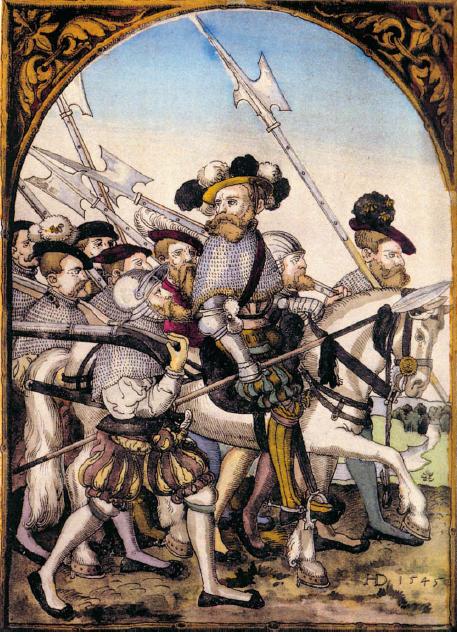| Author |
Message |
Simon G.

|
 Posted: Fri 13 May, 2011 5:47 pm Post subject: 16th c. German spears - construction? Posted: Fri 13 May, 2011 5:47 pm Post subject: 16th c. German spears - construction? |
 |
|
Hi all,
Here are four spears from a manuscripts on the Imperial German army from the early 16th c. :




All four seem to be constructed in the same manner, but I'm not sure what that construction is. While the first one and maybe the fourth one seem to have a socket of sufficient length integral to the spearhead, as usually seen on spearheads, the second and the fourth do not have such a clear socket.
On the other hand, all four have that part of uncertain nature (to me) delimited by two tassels. On the fourth spear it looks bigger than the shaft itself, but on the third spear it appears narrower, and maybe integral to the spear head (very unsure about this; here is a close up).

I was wondering just how the spearhead might be affixed to the shaft on these spears, especially the second and third.
Might the area between the two tassels might be a very long socket? The third one especially gives me this impression. But why such a long socket and wouldn't it be overly heavy (note : these spears are not overly long, they appear to be between 2m and 2,50m in length; the third spear detailed above is held by the horse's cavalier and runs about the length of the horse) ?
Might there be langets, as seen on halberds and glaives but not usually on spears (as far as I know) ? Or even a tang system ?
I'll be very grateful for any thoughts on these spears as I may reproduce one like that in the future.
Thanks in advance,
Cheers !
|
|
   |
 |
Sean Flynt

|
|
   |
 |
|
Scott Woodruff
|
 Posted: Fri 13 May, 2011 8:22 pm Post subject: Posted: Fri 13 May, 2011 8:22 pm Post subject: |
 |
|
|
Those are really cool, I have got to have one! To me, they appear to simply be regular spears like the one Sean posted, with a cloth covering terminating in tassels at each end.
|
|
  |
 |
|
Mrak E.Smith
|
 Posted: Fri 13 May, 2011 11:34 pm Post subject: Posted: Fri 13 May, 2011 11:34 pm Post subject: |
 |
|
Nice pictures! Simon, would you please identify the origin of these pictures? Thanx!
There's a similar example from Kriegsordnung 1545 by Hans Doring may do some help.
 Attachment: 87.68 KB Attachment: 87.68 KB

|
|
  |
 |
Simon G.

|
 Posted: Sat 14 May, 2011 3:41 am Post subject: Posted: Sat 14 May, 2011 3:41 am Post subject: |
 |
|
| Quote: | | The example below is Italian and associated with Henry VIII. My understanding is that the socket extends some distance into the body of the blade in this type. That could have been accomplished the same way some halberd sockets were made--by folding a sheet of steel around a mandrel and forge-welding the halves. |
Ah yes, that is clearly a possibility... I had thought about it but I must confess I don't see the reason for this added complication (at least I guess it is, but I'm not a smith). But I see no other possibility, at least for the spear you posted (unless it's held by a tang and there is some unseen rivet, but I'll readily admit this seems unlikely).
EDIT : going back to the pics I posted, I think you have the good answer, Sean.
If we admit the artist was accurate in his depictions, it appears that there's a relation between the sockets and the blade spines. For instance on the first one where there seems to be a good "standard" socket below the blade, the blade spine is shown to become narrow very quickly:

But on the second and third ones where there is no such "standard" socket, the spine tapers less quickly, and remains thick (i.e. not a simple line) farther down the blade:

This would indeed indicate that the spine compensates the lack of a standard socket by acting as an "inside" socket. I still wonder at the reason for this design. Plus, if my interpretation of the first spearhead is correct, some craftsmen didn't bother as much with this construction and did spearheads that were very similar in looks but mounted mainly with a "standard" socket.
| Quote: | Nice pictures! Simon, would you please identify the origin of these pictures? Thanx!
There's a similar example from Kriegsordnung 1545 by Hans Doring may do some help. |
Mrak, they come from a version of the same Kriegsordnung held in my native town of Besanšon (France).
I would gladly post more but the library can't decide if they're okay with it or not, so it'll have to be just those snapshots... But the third spear I posted is taken from the same scene that you posted.
Thank you all for your comments !
|
|
   |
 |
|
Timo Nieminen
|
 Posted: Sat 14 May, 2011 5:57 pm Post subject: Posted: Sat 14 May, 2011 5:57 pm Post subject: |
 |
|
| Simon G. wrote: | | Quote: | | The example below is Italian and associated with Henry VIII. My understanding is that the socket extends some distance into the body of the blade in this type. That could have been accomplished the same way some halberd sockets were made--by folding a sheet of steel around a mandrel and forge-welding the halves. |
Ah yes, that is clearly a possibility... I had thought about it but I must confess I don't see the reason for this added complication (at least I guess it is, but I'm not a smith). |
It's light. To have the spine solid, and add an "external" socket adds weight. A hollow spine on the blade will support the blade well when thrusting.
It's a sensible lance design - keep the head light so you keep the weapon mobile even with a one-handed grip, strong for thrusts.
It might be harder to make and repair. Also, such a thick-spined head isn't as good for cutting, which isn't a big deal for a lance (or any one-handed spear) - compare triangular and quadrangular lance heads which are even worse for cutting.
"In addition to being efficient, all pole arms were quite nice to look at." - Cherney Berg, A hideous history of weapons, Collier 1963.
|
|
   |
 |
|
|
You cannot post new topics in this forum
You cannot reply to topics in this forum
You cannot edit your posts in this forum
You cannot delete your posts in this forum
You cannot vote in polls in this forum
You cannot attach files in this forum
You can download files in this forum
|
All contents © Copyright 2003-2025 myArmoury.com — All rights reserved
Discussion forums powered by phpBB © The phpBB Group
Switch to the Basic Low-bandwidth Version of the forum
|

